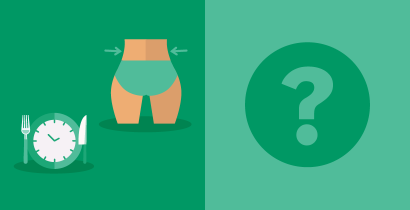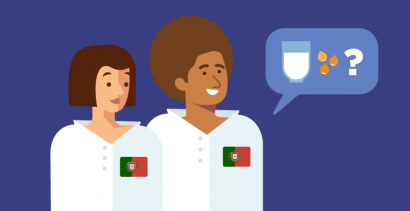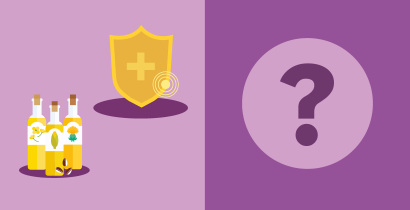Search results for .
Are all ultra-processed foods bad for you?
Found in 19 December 2025Key takeaways: Ultra-processed foods (UPF) cover a huge range of products: from fizzy drinks and sweets to whole grain bread and fortified dairy alternatives. Lumping them all together under one label can be misleading. Not all UPFs affect health the same way. Their impact depends on their type, nutritional value…
Are fresh fruits and vegetables better than frozen, canned, and dried?
Found in 19 December 2025Key takeaways: Fresh, frozen, canned, and dried fruits and vegetables are all nutritious and count toward your 5-a-day. Choose no-added-sugar canned fruit and lower-salt vegetables when possible (<0.3 g salt/100 g). Frozen and canned fruits and vegetables are nutritionally comparable to their fresh counterparts and sometimes superior. Because they last…
Should you avoid eggs because they’re high in cholesterol?
Found in 19 December 2025Key takeaways: Dietary cholesterol from eggs doesn’t directly result in higher blood cholesterol levels for everyone. Most healthy adults can safely enjoy 1-2 eggs/day within a balanced diet. Around 30% of people are “cholesterol hyperabsorbers”, meaning they absorb more cholesterol from their diets due to genetic differences and are at…
Is coconut oil a healthy choice?
Found in 19 December 2025Key takeaways: Coconut oil contains around 84 g of saturated fat per 100 g. Diets high in saturated fats are linked to raising “bad” LDL cholesterol and increasing the risk of heart disease. While coconut oil also raises HDL (“good”) cholesterol, simply increasing HDL does not guarantee better heart health.…
What are dietary reference values (DRVs) used for in nutrition?
Found in 16 December 2025Key takeaways: Dietary Reference Values (DRVs) are a set of reference values for nutrient intake which indicate the amount of an individual nutrient that people need for good health, depending on their age and gender. DRVs are used for dietary assessment, planning diets, and developing dietary recommendations for individuals or…
FOODPathS Releases Final Recommendations to Accelerate Europe’s Food Systems Transformation
Found in 15 December 2025Brussels, December 15th, 2025 – After three and a half years of intensive groundwork, the Horizon Europe project FOODPathS has concluded, leaving behind a strategic legacy designed to accelerate the transformation of Europe’s food systems. The project not only developed a concrete blueprint for future research, innovation, policy and education…
Healthy ageing (2025)
Found in 05 December 2025As people age, the absorption of certain vitamins decreases, and muscle mass, bone mass and appetite tend to decline, making older adults more vulnerable to diet-related conditions. These ageing processes can begin as early as age 40, yet awareness of what can be done from this stage in life remains…
Schelkle, B.(2019).
Found in 04 December 2025The role of microbes in producing our food. AgroFOOD Industry Hi Tech, 30(6).
Schelkle, B.(2019).
Found in 04 December 2025Microbes in the food system. AgroFOOD Industry Hi Tech, 30(5)
Jeruszka-Bielak, M., (...) Hieke, S., & Pietruszka, B. (2018).
Found in 04 December 2025Are nutrition-related knowledge and attitudes reflected in lifestyle and health among elderly people? A study across five European countries. Frontiers in Physiology, 9, 1-13.
Hartman, C., Hieke, S., Taper, C., & Siegrist, M. (2018).
Found in 04 December 2025European consumer healthiness evaluation of ‘free-from’ labelled food products. Food Quality and Preference, 68, 377-388
Grunert, K. G., Hieke, S., & Juhl, H. J. (2018).
Found in 04 December 2025Consumer wants and use of ingredient and nutrition information for alcoholic drinks: A cross-cultural study in six EU countries. Food Quality and Preference, 63, 107-118.
Timotijevic, L., Acuna‐Rivera, M., Gemen, R., Kugelberg, S., McBarron, K., Raats, M. M., & Zolotonosa, M. (2018).
Found in 04 December 2025Adolescents’ perspectives on personal and societal responsibility for childhood obesity—The study of beliefs through ‘serious’ game (PlayDecide). Children & Society, 32(5), 405-416
Sanz, Y., (...), Sadler, C., Fernández, L., & van der Kamp, J. W. (2018).
Found in 04 December 2025Towards microbiome-informed dietary recommendations for promoting metabolic and mental health: Opinion papers of the MyNewGut project. Clinical Nutrition. 37(6 Pt A), 2191-2197
Mariani, J., & Sadler, C. (2018). Making the gut microbiome more “human” through targeted communication. Agro Food Industry Hi Tech, 29(6), 46-48.
Found in 04 December 2025Chang, B.P.I., (...) & Cleeremans, A. (2018).
Found in 04 December 2025Does immersion or detachment facilitate healthy eating? Comparing the effects of sensory imagery and mindful decentering on attitudes and behavior towards healthy and unhealthy food. Appetite, 130, 256-267.
Pachikian, B. D.,(...) Chang, B.,et al. (2018).
Found in 04 December 2025Effets d’un régime à base de légumes riches en inuline sur la santé intestinale et le comportement alimentaire chez le volontaire sain. Nutrition Cliniq
Cell-based meat and other cell-based foods: how it is made and what are the pros and cons
Found in 03 December 2025Key takeaways: Cell-based foods (also called cultivated or lab-grown foods) are made by growing animal, plant or microbial cells in controlled conditions, rather than raising animals or crops in the traditional way. Cultivated meat is produced from animal cells. Its production involves taking a small sample of cells, growing them…
DRG4FOOD delivers 8 food tech innovations that put consumer trust first
Found in 27 November 2025Brussels, November 27th, 2025 – In an era where consumers are increasingly wary of how their food data is used, the EU-funded DRG4FOOD project has delivered a solution: 8 digital food innovations that foster trust alongside technological advancement. After three years and €1.9 million in cascade funding, a mentorship programme…
Pulses (Q&A)
Found in 26 November 2025Key takeaways: Pulses are the edible dried seeds of legume plants, such as lentils, chickpeas, beans, and peas, and are naturally rich in plant-based protein, fibre, B-vitamins, iron, zinc, magnesium, phosphorus, and potassium, while being low in fat and sodium. Despite being nutritious and affordable, pulse intake in Europe is…
Is hexane in food a cause for concern?
Found in 26 November 2025Key takeaways: Hexane is a petroleum-derived solvent widely used to extract oils from seeds such as soybeans, rapeseed, and sunflower. Although almost all hexane residues are removed during refining, concerns are raised because of potential adverse health effects on the nervous, reproductive, and endocrine systems, and of its environmental impact.…
Acrylamide in food: What it is & How to reduce levels
Found in 26 November 2025Key takeaways: Acrylamide forms naturally in starchy foods cooked at high temperatures, such as frying, baking, roasting, and toasting, and is produced when certain sugars react with the amino acid asparagine during the Maillard browning reaction. High levels of acrylamide can cause cancer in animals, and while human evidence is…
What is processed food?
Found in 26 November 2025Key takeaways: Food processing includes a wide range of methods, from washing and chopping to fermenting, freezing, and cooking, and most foods we eat are processed to some degree. Processing brings both benefits and unintended consequences. Benefits include ensuring food safety and making food edible, combatting food waste, tailoring to…
What are food safety risk assessments and why are they used?
Found in 26 November 2025Key takeaways: Food safety risk assessments help determine whether a food or ingredient could pose harm, using a structural process that includes hazard identification, hazard characterisation, exposure assessment, and risk characterisation. Risk assessors and risk managers play different but complementary roles: assessors evaluate the potential harmfulness of a food or…
What happens when we reduce or stop eating meat? A micronutrient breakdown
Found in 26 November 2025Key takeaways: Plant-based diets offer clear health and environmental benefits, including lower risks of heart disease, type 2 diabetes, and some cancers, and a reduced ecological footprint compared to an omnivorous diet. Some nutrients require special attention when cutting back on meat, especially vitamin B12, iron, zinc, calcium, vitamin D,…
How to properly store food in the fridge, freezer and cupboard
Found in 19 November 2025Key takeaways: Storing foods correctly in the fridge, freezer, and cupboard helps to keep them safe, fresh, and flavourful for longer, while reducing food waste. Keep your fridge at maximum 4°C, avoid overcrowding, cool down warm meals to room temperature before storing them within 2 hours, keep raw and cooked…
Fibre in focus: EUFIC calls on Europeans to make the #SwitchToWholeGrains for better health
Found in 17 November 2025Brussels, Date – Fibre is back in the spotlight and for good reason. Diets low in whole grains, one of the main sources of fibre, are linked to more than 145,000 preventable deaths and 2.9 million years of healthy life lost across the European Union, according to the Global Burden…
YOUng AgRifood European INnovators (YOUAREIN)
Found in 05 November 2025YOUng AgRifood European INnovators (YOUAREIN)
EUFIC Communication Lab on sweeteners part two : Targeted recommendations for healthcare practitioners
Found in 27 October 2025In June 2025, EUFIC convened the second part of its online Communication Lab on sweeteners (See the first one from September 2024 here). Over two sessions, this second Lab brought together experts from across Europe, including healthcare practitioners, nutrition scientists, industry representatives and patient association members to translate the latest…
What is nutrient density?
Found in 13 October 2025Key takeaways: Energy density measures the calorie content of foods, while nutrient density refers to the nutrient composition of foods. Energy-dense foods tend to be dry and high in fats (such as biscuits, chips, candy, butter, etc.), whereas less energy-dense foods are usually rich in water and/or fibre such as…
Olive oil: How is it produced? (Infographic)
Found in 01 October 2025Olive oil is enjoyed by many around the world. It is rich in monounsaturated fat, vitamin E and polyphenols. As the name suggests olive oil is produced from the olive fruit of the Olea europaea tree. There are hundreds of varieties of olive trees, many are grown in specific regions…
How to accurately read a scientific paper
Found in 01 October 2025Just because an article cites a scientific study, it doesn’t necessarily mean that the science is high quality. Of course, scientific publications can seem intimidating to read, with their specific and technical language but we can train ourselves to spot unreliable studies. Here are seven things to look for to…
Absolute Risk vs. Relative Risk: What’s the difference?
Found in 01 October 2025Relative risks are often reported in newspaper headlines, but without the context of absolute (or baseline) risk, this information is meaningless. Absolute risk numbers are needed to understand the implications of relative risks and how specific factors or behaviours affect your likelihood of developing a disease or health condition. This…
Difference between correlation and causation (Infographic)
Found in 01 October 2025Correlation does not necessarily mean causation! This infographic will help you understand the difference. While observational research can identify correlations (or associations) but cannot prove causation, other study designs such as randomised controlled trials are used to study and prove cause and effect. Download the printable PDF version here.
Difference Between Hazard and Risk (Infographic)
Found in 01 October 2025This infographic will help you understand the difference between hazard and risk, two terms that are often incorrectly used as synonyms. A hazard is something that has the potential to cause harm, while risk is the likelihood of harm taking place based on exposure to that hazard. Download the printable…
Plant-Based Dairy Alternatives: Perspectives from Nutrition Professionals in Spain and Portugal (2025)
Found in 18 August 2025Plant-based dairy alternatives (PBDAs), such as drinks and yoghurts made of legumes (e.g., soy), oats, nuts (e.g., almonds), rice, or coconut, have become increasingly popular in recent years. To understand how nutrition professionals in Spain and Portugal view these products, EUFIC conducted an online survey between March and May 2025.…
Food science communication trainings
Found in 13 August 2025At EUFIC, we believe science is not finished until it’s communicated. Clear, engaging communication is what makes your research visible, accessible, and impactful. If you’re a food and health researcher looking to share your work more effectively, or a health professional seeking to better engage the public and your peers,…
96% dos nutricionistas portugueses concordam: alternativas vegetais aos laticínios devem ser fortificadas
Found in 08 August 2025Carlos Andrés Zapata, nutricionista: “Comer fruta entera no solo es seguro, es una estrategia protectora para tu salud metabólica”
Found in 08 August 2025Poids : au-delà de l’indice de masse corporelle, voici les 4 meilleures façons de faire évaluer vos risques pour la santé
Found in 08 August 2025Týmto výživovým klamstvám veríte celý život: Vedci odhalili pravdu o tukoch, sacharidoch či „nočnom vyjedaní“
Found in 08 August 2025La Europa que engorda: el 60% de la población es obesa. ¿Vamos camino de convertirnos en EEUU?
Found in 08 August 2025Microbiome testing: What is it, how does it work, and is it regulated?
Found in 31 July 2025Key takeaways: The human gut is home to trillions of microbes, the so called human gut microbiota. Together with the substances they produce, they make up what’s called the human gut microbiome. Microbiome testing kits can provide insights into the gut microbiota; however, research shows they lead to inconsistent results.…
Are juice cleanses good for you and help you lose weight?
Found in 03 July 2025Key takeaways The term “detox” sounds scientific, but most juice cleanses don’t explain what toxins they’re removing or how they do it. Juice cleanses aren’t scientifically proven to improve health. Whilst the so called “detoxifying diets” may be an effective method for short-term weight loss, this is simply due to…
Is the carnivore diet healthy and good for weight loss?
Found in 03 July 2025Key takeaways While it’s tempting to believe that one strict diet holds the key to health, nutrition is more complex. The carnivore diet lacks the long-term evidence needed to recommend it as a healthy and sustainable diet strategy. The carnivore diet can cause deficiencies in fibre, vitamins and minerals, and…
Is intermittent fasting the best way to lose weight?
Found in 03 July 2025Key takeaways Regardless of the diet chosen, creating a calorie deficit is essential to weight loss. Intermittent fasting can be used as a tool to create a calorie deficit. Intermittent fasting can be effective for weight loss if you eat fewer calories than you use. The positive health effects are…
What is the keto diet, and is it a safe way to lose weight?
Found in 03 July 2025Key takeaways Ketogenic diets are not a long-term solution to weight loss. While it may result in short-term weight loss, it’s mostly due to calorie reduction and water weight loss. The claim that carbohydrates, which the keto diet almost entirely restricts, lead to weight gain because they increase insulin levels…
Food allergy (Infographic)
Found in 12 June 2025A food allergy is defined as an abnormal immune response to a food. Although all foods have the potential to cause an allergic reaction, most food allergies are caused by 14 common food allergens. This infographic highlights the 14 common food allergens, the difference between a food allergy and food…
88% of nutrition professionals in Spain agree: plant-based dairy alternatives can be part of a healthy diet, but call for clearer guidance
Found in 12 June 2025Brussels, 12th, June 2025 –– A new survey conducted by the European Food Information Council (EUFIC) reveals strong support among nutrition professionals in Spain for plant-based dairy alternatives (PBDAs), such as drinks and yoghurts made of legumes (e.g., soy), oats, nuts (e.g., almonds), rice, or coconut, with 88% agreeing that…
93 % dos nutricionistas em Portugal concordam: alternativas vegetais aos laticínios podem fazer parte de uma alimentação saudável, mas apelam a uma orientação mais clara
Found in 12 June 2025Bruxelas, 12 de junho 2025 - Um novo inquérito realizado pelo Conselho Europeu de Informação Alimentar (EUFIC) mostra um forte e crescente apoio dos profissionais de nutrição em Portugal às alternativas vegetais aos laticínios, tais como bebidas vegetais e alternativas vegetais ao iogurte, por exemplo, soja, aveia, frutos oleaginosos, arroz…
93% of nutrition professionals in Portugal agree: plant-based dairy alternatives can be part of a healthy diet, but call for clearer guidance
Found in 12 June 2025Brussels, 12th, June 2025 – A new survey conducted by the European Food Information Council (EUFIC) shows strong and growing support among nutrition professionals in Portugal for plant-based dairy alternatives (PBDAs), such as drinks and yoghurts made of legumes (e.g., soy), oats, nuts (e.g., almonds), rice, or coconut, with 93%…
Alternativas de origen vegetal a los lácteos: Perspectivas de los dietistas-nutricionistas en España
Found in 12 June 2025Las alternativas de origen vegetal a los lácteos, como las bebidas y yogures elaborados con legumbres (por ejemplo, soja), avena, frutos secos (por ejemplo, almendras), arroz o coco, se han hecho cada vez más populares en los últimos años. Para conocer la opinión de los dietistas-nutricionistas en España sobre estos…
Plant-Based Dairy Alternatives: Perspectives from Nutrition Professionals in Spain
Found in 12 June 2025Plant-based dairy alternatives (PBDAs), such as drinks and yoghurts made of legumes (e.g., soy), oats, nuts (e.g., almonds), rice, or coconut, have become increasingly popular in recent years. To understand how nutrition professionals in Spain view these products, EUFIC conducted an online survey between March and May 2025. The survey…
Alternativas de origem vegetal aos laticínios: Perspetivas dos Nutricionistas em Portugal
Found in 12 June 2025As alternativas vegetais aos laticínios, tais como bebidas vegetais e alternativas vegetais ao iogurte, por exemplo, soja, aveia, frutos oleaginosos, arroz ou coco, têm-se tornado cada vez mais populares nos últimos anos. Para compreender a opinião dos nutricionistas em Portugal sobre estes produtos, o EUFIC realizou um inquérito online entre…
Plant-Based Dairy Alternatives: Perspectives from Nutrition Professionals in Portugal
Found in 12 June 2025Plant-based dairy alternatives (PBDAs), such as drinks and yoghurts made of legumes (e.g., soy), oats, nuts (e.g., almonds), rice, or coconut, have become increasingly popular in recent years. To understand how nutrition professionals in Portugal view these products, EUFIC conducted an online survey. The survey was shared with national and…
List of the 14 most common food allergens
Found in 09 June 2025Key takeaways Food allergens are substances in food that trigger an immune system response in some individuals, leading to allergic reactions. These allergens are almost always proteins naturally found in food. Symptoms of a food allergy can range from mild to life-threatening and complete avoidance of the allergen is the…
Eating Rate Has Sustained Effects on Energy Intake From Ultra-Processed Diets, New Study Reveals
Found in 02 June 2025Brussels, 2 June, 2025 — A randomized controlled trial (RCT) carried out by researchers from Wageningen University, the Netherlands, has provided new evidence that texture-derived differences in meal eating rate influence energy intake from diets composed of ultra-processed foods (UPFs). Over a 14-day period, participants consuming a UPF diet with…
What is a food allergy? Symptoms, causes and treatment
Found in 28 May 2025Key takeaways: Food allergies involve an immune system response to proteins in foods, leading to symptoms such as itchy eyes, shortness of breath, dry mouth, skin redness and hives, abdominal pain, nausea, vomiting, diarrhoea, and in severe cases swelling of the airways and a drop in blood pressure (anaphylaxis). Food…
DRG4FOOD & FOODITY Final Conference 2025: A Recipe for Trust in Europe’s Food Future
Found in 28 May 2025Brussels, May 28th, 2025 — How can we build a food system that citizens trust—one that protects both our health and our data? This question lies at the heart of the Final Conference of the EU-funded projects DRG4FOOD and FOODITY, taking place at La Tricoterie, Brussels, on 22–23 October 2025.…
How to reduce acrylamide formation at home (Infographic)
Found in 13 May 2025Acrylamide is a chemical naturally formed when starchy foods (e.g. bread, potatoes, biscuits, coffee) are baked, fried or roasted at high temperatures. Prolonged exposure to high levels of acrylamide has been shown to cause cancers in animals. However, the evidence in humans is not as clear. Although humans are usually…
FOODPathS Festival 2025: Building Tomorrow’s Sustainable Food Systems Together
Found in 30 April 2025Brussels, April 30th, 2025 — As the demand for sustainable food systems grows more urgent across Europe, the upcoming FOODPathS Festival (20–22 May 2025) in Brussels will unite a diverse alliance of leaders, researchers, policymakers, funders, educators, and civil society to shape our collective future. This three-day hybrid event will…
From Classrooms to Kitchens: EU’s COMBINE Project Tackles Food Waste Across Europe
Found in 17 April 2025Brussels, April 17th, 2025 – From homes and schools to workplaces and canteens, the COMBINE project supports the EU’s goal to slash food waste by 30% across the Union and is rolling out across multiple settings in Finland, France, Italy, and Portugal. Working closely with local partners, including schools, restaurants,…
FoSSNet: Pan-European Food Systems Science Network
Found in 03 April 2025FoSSNet: Pan-European Food Systems Science Network
Does soy have harmful effects on our health?
Found in 31 March 2025Soy is an important plant-based protein source, particularly for vegetarians, vegans, and those looking to reduce their meat intake. France’s health agency, Agency for Food, Environment, and Occupational Health & Safety (Anses) has recommended to progressively phase out soy and soy-based foods in collective catering menus, such as those in…
Microbioteintestinal : voici la famille d’aliments à privilégier pour l’aider à lutter contre certaines affections
Found in 24 March 2025This food swap could extend your lifespan and help you age better - The Mirror
Found in 24 March 2025Do seed oils cause inflammation?
Found in 19 March 2025Key takeaways Eating seed oils doesn’t increase inflammation. In fact, studies show that higher levels of linoleic acid (the main fat in seed oils) may be linked to lower inflammation in the body. Your overall diet matters more than avoiding specific foods. Seed oils are a healthy source of fats…
Consumer Research: Insights for healthier and more sustainable choices
Found in 26 February 2025What are the main gaps in consumers’ food and nutrition knowledge? Which types of interventions are more promising in reducing the risk of chronic diseases? What information do consumers want to know to eat more healthily and sustainably? Which factors determine how much food consumers waste? These are only some…
Fact-checking resources
Found in 25 February 2025Whether you want to fact-check a claim or sharpen your media literacy skills, this page is your trusted guide to verify science-based information.
Debunking myths
Found in 25 February 2025While debunking myths is part of our work, prevention is just as critical. It’s all too easy to get lost in the sea of diet trends, fads, and conflicting advice. This section breaks down popular food and health claims providing clear, concise, and evidence-based information to help consumers make informed…
Bisphenol A: What is it, its health effects and should we avoid it?
Found in 25 February 2025Key Takeaways Bisphenol A (BPA) is a synthetic organic chemical used in plastics and resins, commonly found in food containers, water bottles and canned food linings. BPA can migrate into food and drinks, especially when plastics are heated, reused for long time, or in contact with acidic or basic substances…
Oligosaccharide
Found in 25 February 2025Oligosaccharide sind eine Art von Kohlenhydraten, die aus einigen wenigen, meist aus 3 bis 10 miteinander verbundenen Zuckermolekülen bestehen. Oligosaccharide können vielerlei Funktionen haben, darunter Zellerkennung und -adhäsion.
Immunglobuline
Found in 25 February 2025Immunglobuline, auch als Antikörper bezeichnet, sind Proteine, die vom Immunsystem produziert werden, um den Körper bei der Abwehr von Krankheitserregern wie Bakterien, Viren und Toxinen zu unterstützen.
Fettgewebe
Found in 25 February 2025Fettgewebe ist ein Bindegewebe, das hauptsächlich aus Fettzellen besteht. Es spielt eine wichtige Rolle bei der Energiespeicherung, der Thermogenese und dem Stoffwechsel im Körper.
Mikrobiota
Found in 25 February 2025Eine Gemeinschaft von Mikroorganismen in einer bestimmten Umgebung.
Oligosacáridos
Found in 25 February 2025Los oligosacáridos son un tipo de carbohidrato formado por una pequeña cantidad de moléculas de azúcar unidas entre sí, normalmente entre 3 y 10. Los oligosacáridos pueden tener muchas funciones, entre ellas el reconocimiento y la adhesión celular.
Inmunoglobulinas
Found in 25 February 2025Las inmunoglobulinas, también conocidas como anticuerpos, son proteínas producidas por el sistema inmunitario para ayudar al organismo a defenderse de patógenos como bacterias, virus y toxinas.
Tejido adiposo
Found in 25 February 2025Los tejidos adiposos también se conocen como tejido graso. Se trata de un tejido conjuntivo compuesto principalmente por células adiposas que desempeñan distintas funciones en el almacenamiento de energía, la termogénesis y el metabolismo del organismo.
Immunoglobulines
Found in 25 February 2025Les immunoglobulines, également appelés anticorps, sont des protéines produites par le système immunitaire afin d’aider le corps à se défendre contre des agents pathogènes telles que des bactéries, des virus et des toxines.
Tissu adipeux
Found in 25 February 2025Les tissus adipeux sont également connus sous le nom de tissu graisseux. Composé essentiellement de cellules graisseuses, ce tissu conjonctif joue un rôle dans le stockage de l’énergie, la thermogénèse et le métabolisme du corps.
Microbiote
Found in 25 February 2025Ensemble de micro-organismes vivant dans un environnement particulier.
Oligosaccaridi
Found in 25 February 2025Gli oligosaccaridi sono un tipo di carboidrato costituito da un piccolo numero di molecole di zucchero legate tra loro, di solito tra 3 e 10. Gli oligosaccaridi possono avere molte funzioni, tra cui il riconoscimento e l’adesione cellulare.
Immunoglobuline
Found in 25 February 2025Le immunoglobuline, note anche come anticorpi, sono proteine prodotte dal sistema immunitario, le quali aiutano l’organismo a difendersi da agenti patogeni come batteri, virus e tossine.
Tessuto adiposo
Found in 25 February 2025I tessuti adiposi sono noti anche come tessuto grasso o grasso corporeo. Si tratta di un tessuto connettivo composto principalmente da cellule adipose, che svolgono un ruolo distinto nell’immagazzinamento dell’energia, nella termogenesi e nel metabolismo del corpo.
Deep dives
Found in 24 February 2025A mix of interviews and webinars taking a closer look into complex food and health topics and their representation in the media with insights from researchers and media professionals.
Media reactions
Found in 24 February 2025Whenever a new food study comes out, headlines may vary wildly with claims of alleged new links to health issues – misrepresenting scientific evidence, lacking context or oversimplifying complex issues. But what does the research actually tell us? We break down the story and share our briefings widely.
Misinformation
Found in 24 February 2025Access to accurate, science-backed information is essential for making healthier choices and improving public health across Europe. Misinformation, however, can distort public understanding and decision-making. At EUFIC we are committed to enhancing food and health literacy by improving the quality of nutrition and food safety coverage in both traditional and…
Ultra-Processed Foods: Consumer perspectives and innovative solutions
Found in 19 February 2025Ultra-processed foods (UPFs) are a pressing issue in public discourse—from health concerns to policy discussions—but what do EU consumers really think? On January 31, 2025, we hosted a dynamic webinar to explore how consumers deal with the UPFs classification, bringing together 9 top experts and over 500 attendees. This engaging…
Which pulses are high in protein?
Found in 10 February 2025Key takeaways: Pulses like lentils, chickpeas, beans, and peas are rich in plant–based protein, containing about 21–25% protein (dry weight) or roughly 8 g per 100 g when cooked. Although some pulses are low in certain amino acids (like methionine), eating a variety of plant foods throughout the day provides…
€80M EU-funded Projects Launch Unprecedented Collaboration to Address the Obesity Crisis in Europe
Found in 06 February 2025Brussels, February 6th, 2025 – Over the past decades, obesity has reached epidemic proportions, now affecting more than 1 billion people worldwide. Childhood obesity, in particular, is rising at an alarming rate. According to the World Obesity Federation, the number of children with obesity is expected to double between 2020…
Microbes4SustainableFoods Cluster Secures €45M+ in EU Funding to Drive Innovation in Sustainable Food and Health
Found in 05 February 2025Brussels, February 5th, 2025 – As the global appetite for sustainable food options continues to grow, microbiome-based innovations such as fermented foods are emerging as a powerful tool for improving human health and protecting the environment. Leading the charge in Europe is the Microbes4SustainableFoods (M4SF) Cluster, a collaboration of EU-funded…





























































